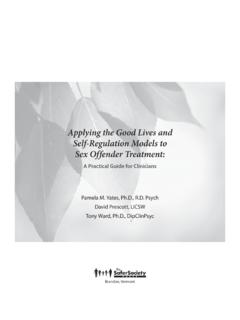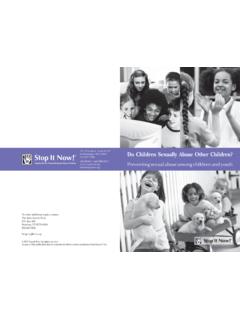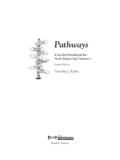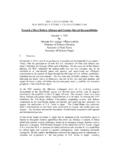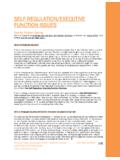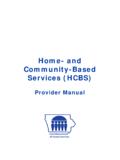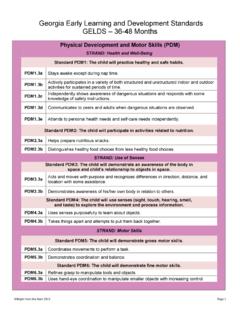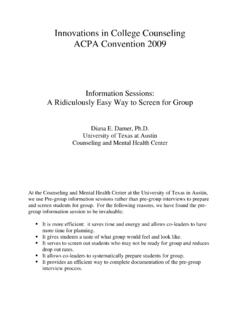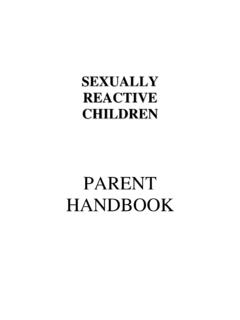Transcription of About This Sample Chapter - Safer Society
1 About this Sample ChapterYou are About to preview the table of contents and Sample Chapter of the new book, The Good Lives Model for Adolescents Who Sexually Harm, which will be published by Safer Society Press in October 2013. We have chosen this Chapter because it is representative of the practical information you can expect to find in all the book will be available for purchase after October 2013 from our Web Store or by calling 2013 by The Safer Society Press, Brandon, Vermont. All rights by Tony Ward ..xIntroductionJulie Morgan ..xChapter 1: Background to the Good Lives Approach to InterventionAnthony Beech ..xChapter 2: The Development of Practice with Adolescents Who Sexually HarmBobbie Print, Dawn Fisher and Anthony Beech ..xChapter 3: The Journey: G-map s Adaptation of the Good Lives ModelHelen Griffin and Laura Wylie ..xChapter 4: Motivating and Engaging Young PeopleElleen Okotie and Paul Quest ..xChapter 5: AssessmentHelen Griffin and Laura Wylie.
2 XChapter 6: Good Lives PlansLaura Wylie and Helen Griffin ..xChapter 7: Therapeutic PracticeLaura Wylie and Helen Griffin ..xChapter 8: TransitionsHelen Griffin and Laura Wylie ..xChapter 9: The Response of Adolescents and Practitioners to a Good Lives ApproachSharon Leeson and Mark Adshead ..xChapter 10: Evaluation of the Adapted Good Lives ModelHelen Griffin ..xCopyright 2013 by The Safer Society Press, Brandon, Vermont. All rights have been familiar with the work of Bobbie Print and the G-map team for many years now and have been lucky enough to visit their center on a number of occasions to share research and therapy ideas. On every occasion I was struck by the tremendous enthu-siasm of the staff for their work with adolescents who harm sexually and their total commitment to clinical excellence. Bobbie and her team are pioneers as well as talented practitioners, always seeking to develop more effective ways of treating young was delighted when Bobbie and the G-map staff decided to adopt the Good Lives model (GLM) as a practice framework to structure their therapeutic work with ado-lescent sex offenders, however, I was curious About just how they would achieve this .
3 Clearly, adolescents are very different from adult who sexually harm and changes would be necessary if the GLM was going to prove useful with this population. After reading the manuscript I have to say, I think it is superb! I am extremely impressed by their painstaking analysis of the GLM and the systematic way they made changes to the model to better fit their practice with adolescents. For example, the way the primary human goods are grouped and the new labels for GLM concepts make perfect sense for this my view, their grasp of the GLM is profound. They have worked with the model from the inside out, making sensible practice adjustments but preserving its core ideas and ethical heart. this is a terrific book that documents G-map s journey with the GLM and demonstrates clearly their clinically creative and skillful translation of it into extremely useful therapeutic guidelines for work with adolescent sex the hands of Bobbie Print and the G-map staff, the GLM has been transformed into a f lexible and clinically sophisticated practice framework capable of integrating cutting-edge and effective techniques within a strength-based framework.
4 The writing is clear and the analysis sure-footed. There is considerable detail on how to go About Copyright 2013 by The Safer Society Press, Brandon, Vermont. All rights Forewordassessing and treating adolescent sex offenders from a GLM perspective, all of which is beautifully illustrated with ongoing case examples. In my opinion, this book is likely to prove a landmark publication in the field of sexual offending and is sure to attract clinicians and researchers alike. It is simply brilliant!Tony Ward, PhD, DipClinPsycProfessor of PsychologyVictoria University of Wellington, New ZealandCopyright 2013 by The Safer Society Press, Brandon, Vermont. All rights 3 The Journey: G-map s Adaptation of the Good Lives ModelHelen Griffin and laura WylieAs a model of rehabilitation the Good Lives model (GLM) appears to have applicabil-ity to a diverse range of populations (Laws and Ward 2011; Sorbello, Eccleston, Ward, and Jones 2002). In the context of working with those who sexually harm, the GLM has been more commonly applied to adults in the United Kingdom (UK).
5 In its origi-nal form, the language and terminology of the GLM lends itself more easily to adult usage, yet the principles and ethos that underpin the model have wider relevance It was this potential that inspired and captured the imagination of a group of practitioners at G-map who were led to embrace the model and adapt it for use with young people. As proponents of strengths-based practice initiatives, the G-map staff was naturally recep-tive to the ideology of the GLM. this Chapter will detail the journey we have under-taken toward a model that has clinical utility specific to the needs of adolescents who display harmful sexual behaviors. It will include descriptions of the adaptations made and the rationale behind them, as well as considering wider implications of the GLM and their significance to the G-map with many other specialist programs (Hanson 2000), G-map historically placed emphasis on the use of the Risk-Need-Responsivity (RNR) model (Andrews and Bonta 2010; Andrews, Bonta, and Hoge 1990; Bonta and Andrews 2007), and the Relapse Prevention model (Marlatt and Gordon 1980; Pithers 1990).
6 The models were tailored to the specific needs and strengths of each adolescent with an emphasis on individualism, Copyright 2013 by The Safer Society Press, Brandon, Vermont. All rights Chapter 3creativity, and f lexibility. this resulted in an array of theoretical models and methods being used and consequently a lack of an overall coherent framework. Moreover, while having an awareness of the importance of adopting a systemic approach with young people (Borduin, Henggeler, Blaske, and Stein 1990) and already engaging families and professionals within its work, G-map lacked a consistent model to support the various GLM proposed by Ward and colleagues, provides a framework that offers f lex-ibility in guiding practice and has the potential to facilitate the involvement of a young person s systems in a more consistent way. By looking at young people more holisti-cally and considering how they might best meet their needs, the focus extends beyond their criminogenic needs, personal skills, and cognitions to encompass and harness the resources that exist externally within their networks and communities.
7 this process means that not only are young persons responsible for change, but the systems around those individuals also hold some accountability for intervention , the GLM provided a conceptual and practical framework that was compat-ible with G-map s organizational aspirations. However, the program s extensive expe-rience of working with young people who display harmful sexual behavior suggested that aspects of the model would benefit from revision in order to be more applicable to that population. Being a small organization meant that G-map had the advantage of being able to adopt a collaborative approach to the exploration and eventual adaptation of the GLM. Consequently practitioners felt empowered and were able to embrace the adapted model as a core framework of their Ward s list of primary GoodsThe first component of the process was considering the utility of Ward s list of primary goods for use with young people. It is valuable to ref lect on the journey undertaken by Ward and colleagues in arriving at a list of needs.
8 In its earliest stages of development there appeared to have been less emphasis on the definitive categorization of goods (Ward and Stewart 2003). Initially Ward (2002) envisaged three classes of primary goods that corresponded to the body, self, and social life. These three classes were inf lu-enced by Deci and Ryan s (2000) Self-Determination Theory of Needs that depicted the pursuit of autonomy, relatedness, and competence as inherent to all individuals. After reviewing the literature across a number of disciplines, including psychology, social science, practical ethics, evolutionary theory, and philosophical anthropology, Ward and colleagues reached the consensus that nine distinct primary goods could be identi-fied, each representing a cluster of related components (Ward and Brown 2004; Ward Copyright 2013 by The Safer Society Press, Brandon, Vermont. All rights Chapter 3and Marshall 2004). While these primary goods have been detailed in Chapter 1, it is useful to revisit them here for the purpose of comparison with G-map s adapted model.
9 They were as follows: L i f e (including physical functioning, healthy living, and sexual satisfaction) Knowledge (including insight and information) Excellence in play and work (including hobbies, leisure, and mastery) Excellence in agency (including making autonomous decisions and being self-directed) Inner peace (including emotional self-regulation and emotional safety) Relatedness and community (including having close and intimate relation-ships with others, and feeling connected to social groups) Spirituality (including finding a sense of purpose and meaning) Happiness (including pleasure and satisfaction, such as that derived from sport, food, and sex) Creativity (including artistic pursuits and seeking novel experiences) (Ward and Marshall 2004; Yates, Kingston, and Ward 2008). The conceptualization of goods within the GLM has continued to evolve, with recent adaptations informed by empirical research.
10 For example, Purvis (2010) sought to examine the etiological assumptions underpinning the classification of goods and proposed that relatedness and community, as well as excellence in play and excellence in work were separate, resulting in the current classification of 11 primary goods ( , Ward and Gannon 2006; Ward, Yates, and Willis 2011).While adopting the primary goods proposed by Ward and colleagues in principle, G-map sought to explore an alternative interpretation and classification of these goods that would be more meaningful to and have greater resonance with its service users. this began with the provisional establishment of eight primary goods or needs, as they were to become known within G-map s adaptation, which had a high correlation with Ward and Marshall s (2004) nine primary goods. These were as follows: Healthy living (including physical health, mental health, and sexual satisfaction) Safety (including having rules and boundaries, stability, self-regulation, and safety for self and others) Knowledge (including creativity and curiosity)Copyright 2013 by The Safer Society Press, Brandon, Vermont.
